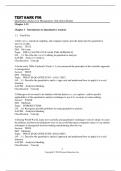Exam (elaborations)
Test Bank for Quantitative Analysis for Management, 14th Edition by Barry Render, Ralph Stair Jr, Michael Hanna| Updated Version
Test Bank for Quantitative Analysis for Management, 14th Edition by Barry Render, Ralph Stair Jr, Michael Hanna| Updated Version
[Show more]
Preview 4 out of 778 pages
Uploaded on
April 17, 2024
Number of pages
778
Written in
2023/2024
Type
Exam (elaborations)
Contains
Questions & answers
Institution
SM+TB
Course
SM+TB
$17.99
100% satisfaction guarantee
Immediately available after payment
Both online and in PDF
No strings attached
1 Copyright © 2024 Pearson Education, Inc. Test Bank for Quantitative Analysis for Management, 14th edition Render Chapter 1 -15 Chapter 1 Introduction to Quantitative Analysis 1.1 True/False 1) Interviews, statistical sampling, and company reports provide input data for quantitative analysis models. Answer: TRUE Diff: Moderate Topic: THE QUANTITATIVE ANALYSIS APPROACH LO: 1.3: Describe the use of modeling in quantitative analysis. AACSB: Analytical thinking Classification: Concept 2) In the early 1900s, Frederick Winslow Taylor pioneered the principles of the scientific approach to management. Answer: TRUE Diff: Moderate Topic: WHAT IS QUANTITATIVE ANALYSIS? LO: 1.1: Describe the quantitative analysis approach and understand how to apply it to a real situation. AACSB: Analytical thinking Classification: Concept 3) Managers do not need to be familiar with the limitations, assumptions, and/or specific applicability of the quantitative analysis technique to use it for accurate decision making. Answer: FALSE Diff: Moderate Topic: INTRODUCTION LO: 1.6: Recognize possible problems in using quantitative analysis. AACSB: Analytical thinking Classification: Concept 4) During World War II, many new scientific and quantitative techniques were developed to assist the military, and these developments were so successful that many companies started using similar techniques in managerial decision making and planning after the war. Answer: TRUE Diff: Moderate Topic: WHAT IS QUANTITATIVE ANALYSIS? LO: 1.1: Describe the quantitative analysis approach and understand how to apply it to a real situation. AACSB: Analytical thinking Classification: Concept NURSEDOCS 2 Copyright © 2024 Pearson Education, Inc. 5) The study of Business Analytics involves the use of large datasets known as big data. Answer: TRUE Diff: Moderate Topic: BUSINESS ANALYTICS LO: 1.2: Describe the three categories of business analytics. AACSB: Analytical thinking Classification: Concept 6) Predictive Analytics is aimed at forecasting future outcomes based on patterns in the past da ta. Answer: TRUE Diff: Moderate Topic: BUSINESS ANALYTICS LO: 1.2: Describe the three categories of business analytics. AACSB: Analytical thinking Classification: Concept 7) When a problem is difficult to quantify, it may be necessary to develop unspecific objectives. Answer: FALSE Diff: Moderate Topic: THE QUANTITATIVE ANALYSIS APPROACH LO: 1.3: Describe the use of modeling in quantitative analysis. AACSB: Analytical thinking Classification: Concept 8) The Quantitative Analysis Approach co nsists of six steps. Answer: FALSE Diff: Moderate Topic: THE QUANTITATIVE ANALYSIS APPROACH LO: 1.3: Describe the use of modeling in quantitative analysis. AACSB: Analytical thinking Classification: Concept 9) A schematic model is a picture, drawing , or chart of reality. Answer: TRUE Diff: Moderate Topic: THE QUANTITATIVE ANALYSIS APPROACH LO: 1.3: Describe the use of modeling in quantitative analysis. AACSB: Analytical thinking Classification: Concept 10) Decision variables may also be called parameters. Answer: FALSE Diff: Moderate Topic: THE QUANTITATIVE ANALYSIS APPROACH LO: 1.3: Describe the use of modeling in quantitative analysis. AACSB: Analytical thinking Classification: Concept NURSEDOCS 3 Copyright © 2024 Pearson Education, Inc. 11) Model variables can be controllable or uncontrollable. Answer: TRUE Diff: Moderate Topic: THE QUANTITATIVE ANALYSIS APPROACH LO: 1.3: Describe the use of modeling in quantitative analysis. AACSB: Analytical thinking Classification: Concept 12) A series of steps or procedures that are rep eated is known as an algorithm. Answer: TRUE Diff: Moderate Topic: THE QUANTITATIVE ANALYSIS APPROACH LO: 1.3: Describe the use of modeling in quantitative analysis. AACSB: Analytical thinking Classification: Concept 13) A model is a representation of a situation. Answer: TRUE Diff: Moderate Topic: THE QUANTITATIVE ANALYSIS APPROACH LO: 1.3: Describe the use of modeling in quantitative analysis. AACSB: Analytical thinking Classification: Concept 14) A parameter is a measurable quantity that may vary or is subject to change. Answer: FALSE Diff: Moderate Topic: THE QUANTITATIVE ANALYSIS APPROACH LO: 1.3: Describe the use of modeling in quantitative analysis. AACSB: Analytical thinking Classification: Concept 15) Trying various approaches and picking the one resulting in the best decision is called incomplete enumeration. Answer: FALSE Diff: Moderate Topic: THE QUANTITATIVE ANALYSIS APPROACH LO: 1.3: Describe the use of modeling in quantitative analysis. AACSB: Analytical thinking Classification: Concept NURSEDOCS 4 Copyright © 2024 Pearson Education, Inc. 16) All problems can be solved by considering only the quantitative issues. Answer: FALSE Diff: Easy Topic: WHAT IS QUANTITATIVE ANALYSIS? LO: 1.1: Describe the quantitative analysis approach and understand how to apply it t o a real situation. AACSB: Analytical thinking Classification: Concept 17) A profit equation is an example of a schematic model. Answer: FALSE Diff: Moderate Topic: THE QUANTITATIVE ANALYSIS APPROACH LO: 1.3: Describe the use of modeling in quantitative analysis. AACSB: Analytical thinking Classification: Concept 18) Testing the data and model should be done before the results have been analyzed. Answer: TRUE Diff: Easy Topic: THE QUANTITATIVE ANALYSIS APPROACH LO: 1.3: Describe the us e of modeling in quantitative analysis. AACSB: Analytical thinking Classification: Concept 19) Sensitivity analysis helps us estimate the effect of known and unknown errors in our model. Answer: TRUE Diff: Moderate Topic: THE QUANTITATIVE ANALYSIS AP PROACH LO: 1.3: Describe the use of modeling in quantitative analysis. AACSB: Analytical thinking Classification: Concept 20) Models can help us analyze a problem and sell a decision to those who must implement it. Answer: TRUE Diff: Easy Topic: HOW TO DEVELOP A QUANTITATIVE ANALYSIS MODEL LO: 1.4: Prepare a quantitative analysis model. AACSB: Analytical thinking Classification: Concept NURSEDOCS




